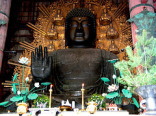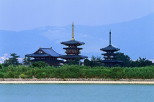World Heritage in Japan 9
Historic Monuments of Ancient Nara
Historic Monuments of Ancient Nara (Culture, registered in 1998)
Nara became the capital of Japan in 710. About 1300 years later Nara was
registered as world heritage. There are 8 historic monuments on the list.
Following properties have constructions of National Treasure and the lands are designated as Historic Site.
1. Todai-ji Temple
Todai-ji Temple, known for its 'Daibutsu-san' or Great Buddha, is a representative
temple in Nara, with an imposing appearance of the largest wooden structure
in the world. As the imperial ordinance by Emperor Shomu was issued for
the construction of Great Buddha, the temple was erected under national
sponsorship so that the Great Buddha would be enshrined. The consecrating
ceremony was held in 752 after 7 years of construction.
The shosoin is the treasure house that belongs to Todai-ji. The building
is in the 'azekura (log-cabin)' style, with a raised floor. It lies to
the northwest of the Daibutsuden. The shosoin houses artifacts connected
to Emperor Shomu (701-756) and Empress Komyo (701-760), as well as arts
and crafts of the Tempyo period of Japanese history.
The treasures came from Japan, China and Persia which consist of excellent ancient art crafts like paintings, calligraphies, goldworks, lacquer-works, woodworks, glasswares, musical instruments and masks. There are also historical documents like Shosoin-monjo, documents related to the consecrating ceremony of Great Buddha, ancient medicine and so on. So it is valuable repository of history.
2. Kofuku-ji Temple
The Kofuku-ji Temple, situated next to the Todai-ji Temple, was prosperous
as a forerunner of "Buddhism for aristocrats" in the Nara period.
Among the seven biggest temples of Nara, the Kofuku-ji Temple has developed
through the closest relationship with the town of Nara. In 710, the Umayasaka
Temple, the predecessor of the present Kofuku-ji Temple, was transferred
from Asuka to the Nara capital by Fujiwara-no-Fuhito. Then, as a tutelary
temple of the Fujiwara family, it extended its influence with the prosperity
of the family.
It was rebuilt several times after the fire.
3. Kasuga-Taisha (Kasuga Grand Shrine)
In 768, shrine buildings started to be constructed here by Fujiwara family.
In the first half of the Heian period (794-1192), shrine buildings were
completed on the same scale as they are today. After the Middle Ages, the
belief was prevalent among commoners, which is shown by the fact that various-shaped
hanging lanterns and stone lanterns known as "Mantoro" were mostly
the donations from common people.
The Shrine lies in a primeval forest of cedars and a kind of Chinese black
pines. The brilliant vermillon edifices are beautifully contrasted with
their surrounding greenery. Going through the first and second Torii gates,
you can see a lot of stone lanterns standing on both sides of the approach
to the shrine. Going on further, you will find the south gate on the left.
The main hall is located among trees behind the gate. From the gate a corridor
extends to the left and to the right. A great number of lanterns hung from
the eaves of the corridor are producing an elegant atmosphere.
4. Gango-ji Temple
This edifice used to be a part of the priests' living quarters of the Gango-ji
Temple, and was reconstructed as its main hall (National Treasure) and
Zen hall (National Treasure) in the Kamakura period (1192-1333). The temple
has attracted commoners since the Middle Ages. Numerous stone Buddhas and
folk materials were discovered in the precincts. Thanks to the grand repair
from the 25th to 29th year of Showa (1950-1954), we can enjoy appreciating
the temple structures at the time of the Kamakura period's reconstruction.
In the storehouse are a small wooden five-storied pagoda (National Treasure),
a wooden sitting statue of Amida Buddha, Chiko Mandala, an abundance of
articles on folk belief, and so on.
5. Yakushi-ji Temple
The establishment of the temple started in 680 with the wish of Emperor
Temmu that Empress would recover from her illness. With the transfer of
the capital to Nara, the temple was moved to the present site in 718. Two
three-storied pagodas (the East Pagoda and the West Pagoda) are placed
centering around the Golden Hall and Lecture Hall. The arrangement of the
temple buildings is so unique that the style of this temple is called "Yakushi
Style". A fire broke out several times and most of the buildings were
burned down. The East Pagoda is now the only structure that was constructed
at the time of the foundation of the temple. The other buildings including
the Golden Hall were reconstructed, and finally in 1982, the West Pagoda
was completed. The popular visiting course is to start from the station
and begin with the Lecture Hall. Another course can be to go through the
south gate and then visit the East Pagoda, the West Pagoda, the Golden
Hall, the Bussoku-do Hall, Toin-do Hall,and the Lecture Hall in this order.
6. Toshodai-ji Temple
This temple was founded in 759 by the Chinese Buddhist priest Ganjin Wajo,
who, with the invitation of Emperor Shomu, came to Japan after going through
all sorts of hardships. The whole temple, including the Golden Hall called
"Tempyo-no-Iraka," the Lecture Hall and the Treasure Hall, still
keeps its original appearance. The temple buildings are beautifully arranged,
which shows us broad-mindedness of the people of the Tempyo era.
Following properties are designated as Special Historic Spot or Special
nntural Monument.
7. Heiji Palace Site
The Heijo Palace was built in 710 as the center of Heijo-kyo Capital, which
lasted for 74 years over the 7 successive reigns. The Palace was located
in the northernmost area of the central Heijo-kyo Capital and, with an
extended area toward the east, it had a total area of about 120 hectares.
Containing the Daigoku-den and the Chodo-in for formal ceremonies, the
Dairi as an emperors' residence, the To-in, and government offices with
8 ministries and 100 agencies, the Palace is considered to have been surrounded
by mud walls and moats with a total of 12 gates, 3 gates being built in
each direction. A continuous excarvation has been carried out by the Nara
National Cultural Properties Research Institute since the 34th year of
Showa(1959). Moreover, the "Suzaku-mon," or the formal gate to
the Heijo Palace, and the "To-in" Garden, or the site of aristocrats'
banquets and ceremonies, were restored and have been open to public since
1998.
8. Kasuga-Hill Primavel Forest
The highest peak of Kasuga-Hill is Mt. Hanayama (498m) and the unbrella
shaped mountain east of Kasuga Grand Shrine is Mt. Mikasa. As this is a
divine hill of the Kasuga Grand Shrine, the trees in the whole area of
the hill behind the shrine have been prohibited from cutting down for more
than 1,000 years. The hill is covered with a primeval forest of cedars,
firs and cypresses. Rare animals such as a polypedatid and a kind of corbicula
(Natural Monument) inhabit the hill, where it is dark even in the daytime
because the area is located deep in the forest.
(Reference: Website of Nara City Sightseeing Information Center)
How to access from Tokyo (example)
Tokyo Station-(Shinkansen)-Kyoto Station-(Kintetsu Line)
-KintetsuNara Station
From Kintetsu Nara or other stations around, you can walk or take a bus.
Total time: about 3.5 hours

|
|

Kofuku-ji Temple: Symbolic landscape of Nara
 Top page Top page
 General information of Japan General information of Japan
 World heritage in Japan World heritage in Japan
-Horyuji Temple
-Himeji Castle
-Yaku Island
-Shirakami Mountain Range
-Ancient Kyoto
-Shirakawa-go and Gokayama
-Hiroshima Peace Memorial
-Itsukushima Shrine
-Ancient Nara
-Shrines and Temples in Nikko
-Kingdom of Ryukyu
-Kii Mountain Range
-Shiretoko
-Iwami Silver Mine
-Ogasawara Islands
-Hiraizumi
-Mount Fuji
-Tomioka
-Site of Industrial Revolution
-Architectural Work of Le Corbusier
-Okinoshima & Munakata
 Accommodation in Japan Accommodation in Japan
 Japanese food Japanese food
 Japanese culture (National Treasures) Japanese culture (National Treasures)
 Japanese culture 2 (Culture in everyday life) Japanese culture 2 (Culture in everyday life)
 Japanese sports Japanese sports
 Japanese religion Japanese religion
 Souvenir of Japan Souvenir of Japan
 continually updated ! continually updated !
 Travel Diary in Tokyo Travel Diary in Tokyo
 My profile My profile
 Link Link
 English Guiding Service English Guiding Service
 info@ltij.net
info@ltij.net
|


